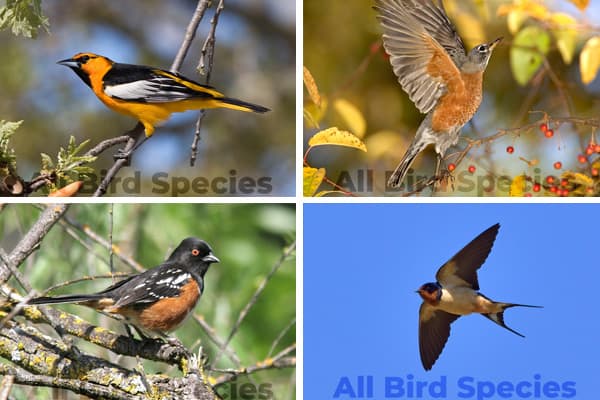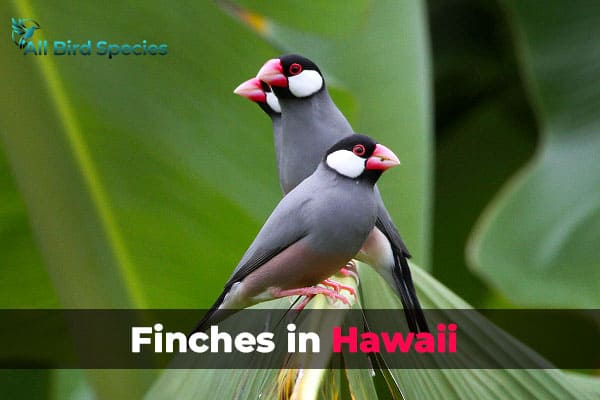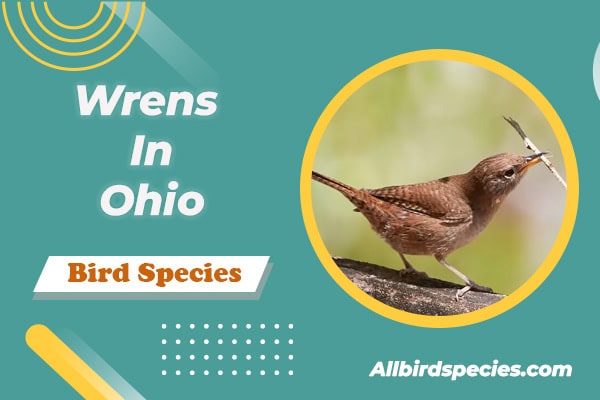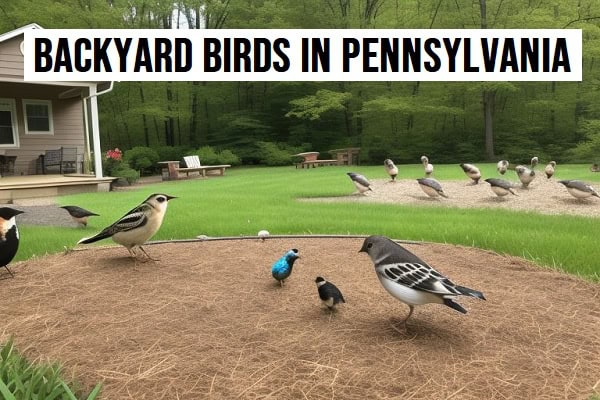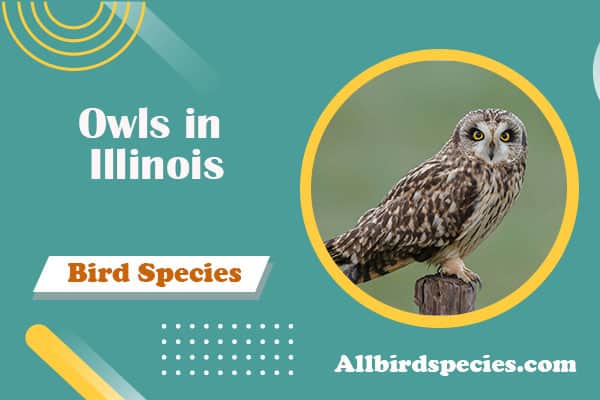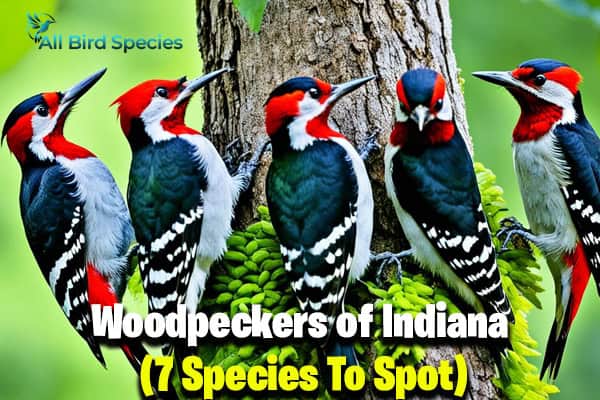7 Orange and Black Birds in Colorado (With Photos)
Did you know the Barn Swallow migrates up to 5,000 miles? It goes from North America to Central and South America. This shows how diverse bird life is in Colorado, especially the orange and black birds in Colorado.
Birdwatchers love these birds for their beauty and complexity. They need a good identification guide to find them in the wild.
In this guide, we’ll look at common and rare orange and black birds in Colorado. You’ll learn about the Bullock’s Oriole and the American Redstart. Each bird has its own look, home, and way of acting. With photos, finding these birds is fun and easy. Let’s explore the amazing world of these birds!
Overview of Orange and Black Birds
Colorado is home to over 500 bird species, with many being orange and black. The Bullock’s Oriole is one, known for its bright colors and varied diet. The Lark Bunting, Colorado’s state bird, shows off these colors in the Plains.
Some birds, like the Rufous Hummingbird, fight to keep their food spots. Knowing about these birds makes birdwatching in Colorado even better.
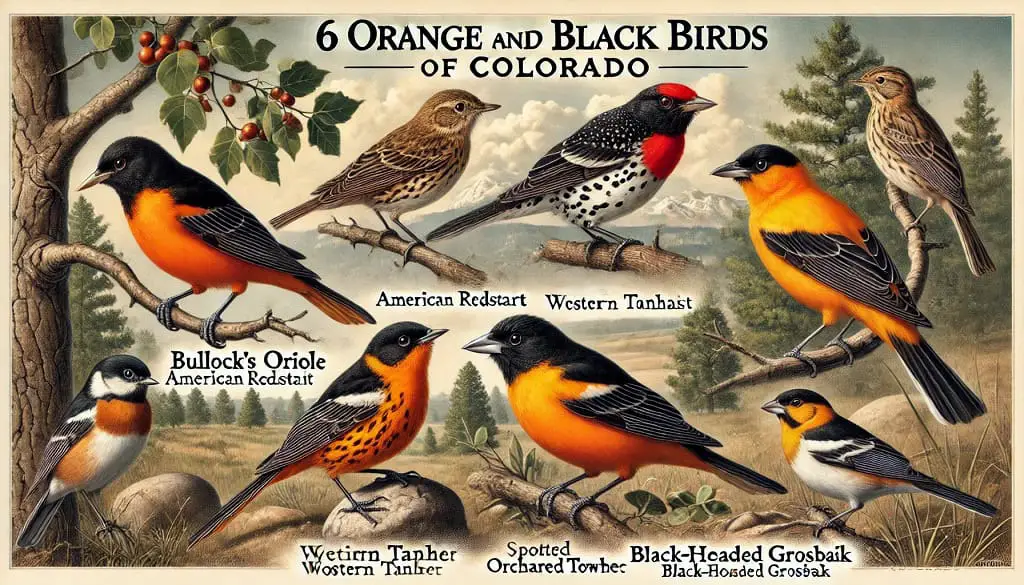
Importance of Birdwatching in Colorado
Birdwatching in Colorado lets you explore amazing bird habitats. The state’s mountains and plains offer chances to see many birds. Thanks to conservation, Bald Eagles are coming back, showing the impact of caring for birds.
Watching birds also teaches us about the environment. It helps us protect these amazing creatures while enjoying their beauty.
| Bird Species | Habitat | Behavior | Conservation Status |
|---|---|---|---|
| Lark Bunting | Plains regions | Forages for seeds | Stable |
| Bald Eagle | Open terrain and reservoirs | Solitary, impressive hunter | Increasing |
| Rufous Hummingbird | Woodlands and gardens | Aggressive territorial defender | Stable |
| Boreal Owl | High alpine areas | Nocturnal hunter | Stable |
| Bohemian Waxwing | Social groups in forests | Forages in groups | Stable |
Colorado is Home to a Variety of Birds
Colorado is a great place for birdwatching. It has over 520 bird species. You can see many different birds in different places.
Birdwatching Opportunities
Colorado has many places to see birds. You can visit national parks like Rocky Mountain National Park. Or state parks like Chatfield and Cherry Creek. There, you might see:
- Downy Woodpecker – 6-7 inches, weighing 1 oz, with a wingspan of 13 inches.
- Hairy Woodpecker – slightly larger at 7-10 inches and 1.5 oz, boasting a wingspan of 16-20 inches.
- Northern Flicker – 8-10 inches and 2.5 oz with a wingspan of 14-16 inches.
- Acorn Woodpecker – 7-9 inches and 3-5 oz, wingspan 13-17 inches.
- Red-Naped Sapsucker – 7-8 inches, weighing between 1-1.6 oz and a wingspan of 13-16 inches.
Seasonal Changes in Bird Migration
The bird migration adds fun to birdwatching. In spring and fall, many birds come and go. This is a great time to see special birds.
Unique Characteristics of Orange and Black Birds
Orange and black birds are a stunning sight in Colorado. Their bright colors help them find mates and warn off predators. Knowing about these birds makes birdwatching more fun and helps you identify them.
Significance of Their Coloring
The bright orange and black colors of these birds are important for talking to each other. During mating season, males show off their brightest colors to attract females. This color difference helps us tell different types of orange and black birds apart.
Habitat Preferences
Where these birds live in Colorado is key to finding them. They like places like:
- Forests: Dense trees give them shelter and places to nest.
- Riparian areas: Being near water helps them find food and nest.
- Urban parks: These parks attract birds looking for a mix of nature and people.
Each place helps these birds survive and have babies. Knowing where to look can help you see these special birds in the wild.
Top Orange and Black Birds of Colorado
Colorado is home to many colorful birds. You can see the Bullock’s Oriole and the American Robin. These birds add beauty to the state’s landscapes.
Great places to see these birds are near water and forests. These areas are perfect for birdwatching.
Birding Hotspots for Viewing
Looking for a birdwatching spot in Colorado? Here are some great places:
- Denver’s Cherry Creek Reservoir: See American Robins and Bullock’s Orioles here.
- Chatfield State Park: Spot Red-breasted Nuthatches and Spotted Towhees in this park.
- Horsetooth Reservoir: Watch for Barn Swallows and American Redstarts here.
- Royal Gorge Bridge and Park: See Black-headed Grosbeaks in the spring and summer.
These spots are great for seeing Colorado’s colorful birds. Don’t forget your binoculars for a fun birdwatching trip!
1. Bullock’s Oriole
The Bullock’s Oriole is a bright bird to watch. It has an orange body and black wings with white bars. This makes it easy to spot. You can find it in open woodlands across Colorado.

Description and Identification
Look for males with shiny black wings and bright orange bodies. Females are yellowish with orange and brown hints. Their colors help you spot them in trees or shrubs. They can even hang upside down, which is cool to see.
Habitat and Behavior
Bullock’s Orioles like open woodlands and places near water. They eat fruit and nectar. You can attract them with orange slices or jelly in your garden.
They like to be with others and often hang out in groups. In late spring, they breed. Females lay 4 to 5 eggs that hatch quickly, showing how fast they grow.
Best Time to Spot
The best time to see Bullock’s Orioles is from late spring to early summer, when they are most active. Watching them at dawn or dusk is a good idea.
2. American Redstart
The American Redstart is a bright songbird. It has a black body with orange wings and tail. Watching it in nature is fun for bird lovers.

Description and Identifiable Features
This bird is known for its bright colors and fast flight. Males have black and orange, while females and young have yellow and gray. They look amazing in the woods.
Feeding Habits and Nesting
The American Redstart eats flying insects. It catches them in mid-air with its quick moves. They nest near water in shrubs.
Males work hard to protect their nests. These nests are usually small, less than 2 hectares.
3. Western Tanager
The Western Tanager is a stunning bird. It has bright colors and unique traits. It has a yellow body, a reddish-orange head, and black wings. Seeing this bird is a joy, especially when you know how to spot it.
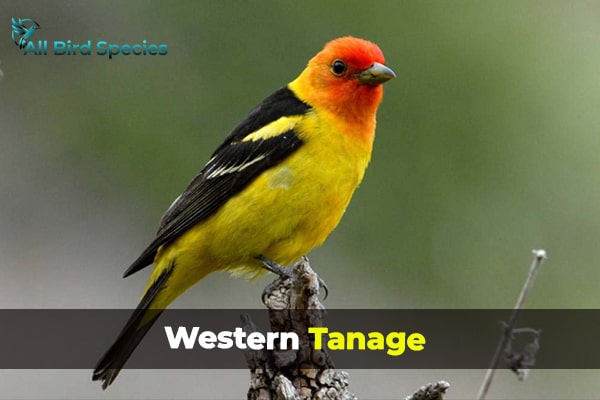
Appearance and Key Identification Traits
Male Western Tanagers are more colorful than females. Females are yellow-green. Their bright colors help them stand out in the trees.
Adult males have a yellow body and a reddish-orange head. They also have black wings. These colors help them attract mates and are easy to spot.
Preferred Habitats
Western Tanagers like open forests at high elevations. They need trees to find food, and these places are great for nesting and raising young.
Birdwatchers see them best in summer. Places with lots of trees and shrubs are perfect for them.
| Trait | Description |
|---|---|
| Male Appearance | Bright yellow body, reddish-orange head, and black wings |
| Female Appearance | Yellow-green with less vibrant colors |
| Preferred Habitat | Open coniferous forests at higher elevations |
| Feeding Habits | Forages for insects and berries among the trees |
| Best Observation Time | Summer, particularly in regions with ample trees |
4. Lesser-Known Orange and Black Birds in Colorado
Exploring Colorado’s bird world is exciting. You’ll find many birds, some well-known, others not so much. These orange and black birds are special. They help keep Colorado’s nature healthy.
Learning about these birds makes birdwatching better. You’ll see the beauty of birdlife in a new way.

Overview of Lesser-Known Species
The rusty blackbird is rare now. It used to live in wetlands but is now hard to find, so birdwatchers need to look for it.
The Brown-headed Cowbird is interesting. It lays eggs in other birds’ nests. This helps it live in many places. It can lay eggs in over 220 different species’ nests.
The Yellow-headed Blackbird is known for its bright yellow head. It lives in wetlands and makes them colorful.
Here’s a table showing some key facts about these birds:
| Bird Species | Average Length (inches) | Weight (oz) | Wingspan (inches) |
|---|---|---|---|
| Rusty Blackbird | 8.3 – 9.8 | 1.5 – 3.0 | N/A |
| Brown-headed Cowbird | 7.9 – 8.7 | 1.2 – 2.4 | N/A |
| Yellow-headed Blackbird | 8.3 – 9.8 | 1.6 – 3.5 | N/A |
When you go birdwatching in Colorado, look for these birds. They make the bird world more interesting. They also show us how nature works.
5. Spotted Towhee
The Spotted Towhee stands out. Its head and back are black, its flanks are orange, and its belly is white. Knowing how to spot this bird is key when birdwatching in Colorado.
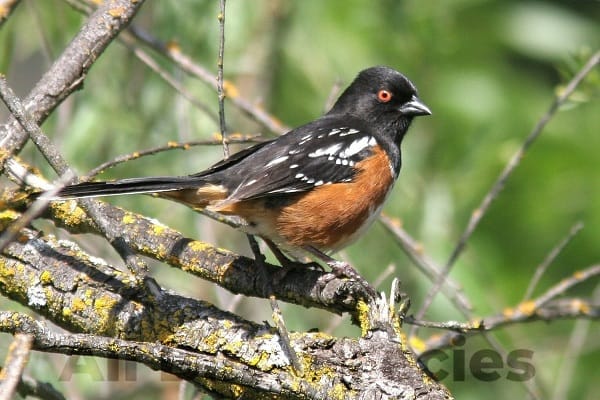
Description and Nesting Behavior
The Spotted Towhee is easy to spot because of its colors. It likes to nest in dense brush or forest edges. This keeps it safe from predators.
Nesting happens in the spring. Both parents help raise the chicks. Look for their ground-foraging habits as they search for food.
Learning about the Spotted Towhee’s nesting habits is fun. Watching where they nest helps you learn more. With over 500 bird species in Colorado, seeing a Spotted Towhee is special.
6. Orchard Oriole
The Orchard Oriole is a bird you might see in Colorado in the summer. Its bright colors help distinguish males from females. Males are bright orange with black wings and heads, while females are yellowish-green.

This makes spotting them fun for birdwatchers.
ID Features and Feeding Preferences
Orchard Orioles love to eat fruits, especially mulberries and berries. They pick places to nest where there’s lots of food. You can find them high up in trees, looking for food.
They are hard to find at bird feeders. But, their nests are cool. They make hanging nests from thin fibers in trees. The best time to see them in Colorado is during the summer when they are busy.
| Feature | Male | Female |
|---|---|---|
| Coloration | Reddish-orange body, black wings, and head | Yellowish-green body, olive undertones |
| Feeding Habits | Fruits, especially berries | Similar, primarily fruits |
| Nesting | Hangs nests from fine fibers | Participates in nest building |
| Best Observation Time | Summer breeding season | Summer breeding season |
7. Black-Headed Grosbeak
The Black-Headed Grosbeak is a bird that catches the eye. It has bright orange underparts and a black head. This makes it easy to spot in Colorado’s open areas.
Its looks and sounds make it a favorite among birdwatchers. They love to see and hear this bird.

Identification and Call
Look for certain things to tell if you see a Black-Headed Grosbeak. Males have bright colors, while females are more calm. Their songs are sweet and can be heard in spring and summer.
Their calls last about two to three seconds. They sound very musical.
This bird likes to hop around while looking for food. It also loves nectar feeders. In Colorado, 100% of them visit bird feeders. This is a great chance to see them up close.
Knowing how to spot these birds makes birdwatching better. You can find them in many places in Colorado. Just listen for their songs to find them.
How to Spot Orange and Black Birds in Colorado?
Seeing orange and black birds in Colorado is exciting. To find them, you need the right gear and know where to look. Learning about their habits and homes will improve your birdwatching.
Birdwatching Gear Recommendations
Good birdwatching gear is key. You should have:
- Binoculars: Get high-quality binoculars for clear views. Look for 8x to 10x magnification.
- Field Guides: A Colorado bird guide helps identify orange and black birds.
- Notebook: Use a journal to record your bird sightings. Note where and when you saw them.
- Camera: Take pictures of the birds you see. A camera with a good zoom is best.
Top Locations and Tips
Colorado has many great places to see birds. Here are some top spots:
- Rocky Mountain National Park: It’s full of different birds. You might hear Black-capped Chickadees and see Gray Jays.
- San Juan National Forest: It’s great for Brown-capped Rosy Finches, especially at high elevations.
- Cherry Creek State Park: This park is full of life. You can see Orioles and water birds like Belted Kingfishers.
- Mesa Verde National Park: It offers a chance to see unique habitats of orange and black birds.
Be patient and quiet when birdwatching. Early mornings are best. Using your binoculars well can help you see these beautiful birds. Follow these tips to see more orange and black birds in Colorado.
Conservation Status of Colorado’s Orange and Black Birds
The health of orange and black birds in Colorado is very important. These birds help keep our ecosystems balanced. We need to know about their dangers and how we can help them.
Threats to Their Populations
Many dangers threaten the lives of these birds. Some big problems include:
- Habitat Loss: Humans building cities and farms take away their homes.
- Climate Change: Weather changes and warmer temperatures mess up their lives.
- Human Interference: Pollution and hunting make it hard for them to survive.
The piping plover is a good example. It’s in danger because of lost homes along lakes and rivers.
Conservation Efforts in Progress
Colorado is working hard to save these birds. They are doing many things to help:
- Protected Areas: They create safe places for birds to live and travel.
- Community Engagement: They get people involved in helping the birds.
- Research and Monitoring: They study the birds to see what works best.
Colorado’s efforts are crucial for the future of these birds. By fighting threats and protecting them, they aim to keep our skies full of life.
| Threats to Birds | Description |
|---|---|
| Habitat Loss | Urbanization, agriculture, and industrial activities reduce natural habitats. |
| Climate Change | Changes in weather patterns affecting migration and breeding cycles. |
| Human Interference | Pollution, hunting, and other activities harm bird health and populations. |
Birdwatching Etiquette and Best Practices
Being kind to birds and nature makes birdwatching better. It also keeps birds and their homes safe. Here are some important rules to follow for a good birdwatching time.
Respect for Nature and Habitats
As a birdwatcher, you help take care of the earth. Showing respect for nature means:
- Keeping a safe distance from nests and where birds sleep not to stress them.
- Being quiet not to scare away animals.
- Walking only on paths to protect the land.
- Not using bird calls not to confuse or scare birds, especially when they are making babies.
- Helping to keep places clean for birdwatching.
By being kind to birds, you help protect Colorado’s birds. Being respectful helps us all love wildlife more. Your actions can make a big difference for birds and the earth.
Final Thoughts;
Birdwatching in Colorado is a vibrant experience. It’s especially fun when you see orange and black birds in the sky. These birds add color and show us how nature works.
When you go birdwatching, remember to help protect these birds. Helping wildlife keeps Colorado’s bird life rich. By supporting local efforts, you help future generations see these birds too.
Birdwatching in Colorado is truly special. It’s great for both new and experienced birdwatchers. Exploring nature helps us love and protect these amazing creatures. Let your love for nature lead you to discover more in Colorado’s skies.
Our Recommended Bird 🐦Related Articles~
- Can Ducks Eat Cucumber?
- Two Birds on a Wire Meaning
- White Birds In Michigan
- Red Birds in Michigan
- White Birds in Florida
- Red Birds in Florida
- Types Of Doves in Illinois
Frequently Asked Questions
Q1: What is a bird in Northern Colorado with black wings, white belly, and iridescent green back?
Likely the Black-billed Magpie, common in Colorado. They have a black and white color pattern with iridescent greenish-blue on their wings.
Q2: What’s the name of the bird that lives in the US Midwest with black wings and a red chest?
This is most likely the Red-winged Blackbird, commonly found in wetlands and marshy areas across the Midwest.
Q3: What is a black iridescent bird with a blue head?
The bird described is likely a Common Grackle, which has iridescent black plumage and a distinctive blue head.
Q4: What is the name of the long-tailed white, blue, and black bird?
This is a Black-billed Magpie, also known as the American magpie, which is commonly found in Colorado and other regions.
Q5: What would cause a red-winged blackbird to attack?
Red-winged Blackbirds are highly territorial and aggressive, especially during nesting season when they defend their nests from perceived threats.
Q6: What is the name of a small bird with a brown back and a black body?
This sounds like a Scaly-breasted Munia, also known as the nutmeg mannikin or spice finch.

